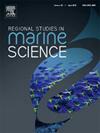利用环境DNA表征印度马纳尔湾港口和船舶压载水中的微生物多样性
IF 2.1
4区 环境科学与生态学
Q3 ECOLOGY
引用次数: 0
摘要
海洋生态系统中有丰富的微生物群落,它们对营养循环和生态系统的整体健康至关重要。保护本地微生物多样性对维持生态系统稳定至关重要;然而,人类活动,特别是海上运输,通过压载水排放带来了引入非本地物种的重大风险。尽管马纳尔湾具有重要的生态意义,但关于其港口和压载水中微生物多样性的数据仍然很少。本研究旨在利用16S rRNA扩增子测序来表征马纳尔湾港口和压载水中的微生物多样性。分析显示,两种水源中均存在优势门,包括变形菌门、拟杆菌门、plantomycetes和放线菌门,强调其重要的生态作用。在属水平上,压载水中以Alteromonas、Neptuniibacter、aestuaribacter、Pirellula、Pseudoalteromonas、Thalassotalea、Rubripirellula、Vibrio、Algicola和Blastopirellula等属为主,港湾水中则以Alteromonas、Oleibacter、uncultulebacterium、Pirellula、Blastopirellula、Tropicimonas、Marinobacter、Neptuniibacter、Illumatobacter和Candidatus-actinomarina等属为主。多样性指数显示,港口水域的物种丰富度较高,压载水的物种丰富度较高。在两种环境中,物种丰度存在显著差异,特别是嗜盐嗜碱菌(Acht6.2)嗜盐嗜碱菌(Oleiphilus messimensis)、Marinobacter和Marinomonas中的各种物种以及Verrucomicrobiales和Dadabacteriales。本研究提供了马纳尔湾港口和压载水微生物生物多样性的基线,提供了微生物群落动态的见解,并为管理策略提供信息,以减轻该地区压载水排放相关的生态风险。本文章由计算机程序翻译,如有差异,请以英文原文为准。
Characterization of microbial diversity in the harbour and ballast water of ships in the Gulf of Mannar, India using environmental DNA
Marine ecosystems are rich in diverse microbial communities, which are vital to nutrient cycling and the overall health of the ecosystem. Preserving native microbial diversity is crucial for maintaining ecosystem stability; however, human activities, particularly maritime shipping, pose a significant risk of introducing non-native species through ballast water discharge. Despite the ecological significance of the Gulf of Mannar, data on the microbial diversity in its harbour and ballast waters remain sparse. This study aimed to characterize the microbial diversity in the Gulf of Mannar’s harbour and ballast waters using 16S rRNA amplicon sequencing. Analysis revealed the presence of dominant phyla, including Proteobacteria, Bacteroidetes, Planctomycetes, and Actinobacteria, in both water sources, underscoring their significant ecological roles. At the genus level, ballast water was dominated by species such as Alteromonas, Neptuniibacter, Aestuariibacter, Pirellula, Pseudoalteromonas, Thalassotalea, Rubripirellula, Vibrio, Algicola, and Blastopirellula, while harbour water exhibited species abundance from genera like Alteromonas, Oleibacter, Uncultured-bacterium, Pirellula, Blastopirellula, Tropicimonas, Marinobacter, Neptuniibacter, Illumatobacter, and Candidatus-actinomarina. Diversity indices showed higher species richness in harbour water but greater abundance in ballast water. Significant differences in species abundance were identified between the two environments, notably in Oleiphilus messimensis, a haloalkaliphilic bacterium (Acht6.2), various species within Marinobacter and Marinomonas, and the orders Verrucomicrobiales and Dadabacteriales. This study provides a baseline of microbial biodiversity in the Gulf of Mannar’s harbour and ballast waters, offering insights into microbial community dynamics and informing management strategies to mitigate ecological risks linked to ballast water discharge in the region.
求助全文
通过发布文献求助,成功后即可免费获取论文全文。
去求助
来源期刊

Regional Studies in Marine Science
Agricultural and Biological Sciences-Ecology, Evolution, Behavior and Systematics
CiteScore
3.90
自引率
4.80%
发文量
336
审稿时长
69 days
期刊介绍:
REGIONAL STUDIES IN MARINE SCIENCE will publish scientifically sound papers on regional aspects of maritime and marine resources in estuaries, coastal zones, continental shelf, the seas and oceans.
 求助内容:
求助内容: 应助结果提醒方式:
应助结果提醒方式:


